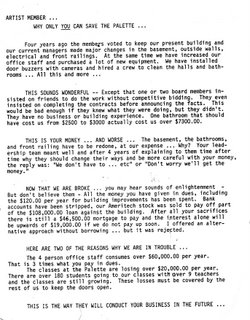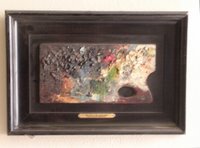History of the Palette: the last 25 years - Part One
It was the custom in ancient China for the bureaucrats of each dynasty to write the history of their own era -- but only after their dynasty had fallen and been replaced by the next one. (BTW - the Communists did the same thing: locking the captured officials of the Kuomintang into a special prison --- giving them ink and paper, and commanding them to start writing -- the results of which was printed and circulated to only the highest party officials)
So now -- having been voted off the board by a landslide majority -- I think I'll begin my retirement by writing the P&C's history - at least the part with which I am familiar.
This being a blog -- your contributions, corrections, or contrary opinions are welcome
..................................................................................................................
The biggest event of the P&C's post-war history was opening up the membership to women in the sixties. But after that -- the biggest event was the growth of the 1980's, when the membership went from 75 to 150 and the weekly hours of open workshop went from 14 to 40.
In the late 70's, there were 2 evening workshops, one afternoon workshop, and the 5-hour workshop on Sunday. On Saturday Walter Parke taught a class in portrait painting. A caretaker lived in the basement -- who maintained the building in exchange for free rent -- and the coach house was rented out as apartments.
But during the eighties, there was a more inviting attidude towards new members. Many new studios opened up when the coach house was converted from apartments to studios --following a frozen-pipe catastrophe that left it vacant for six months.
In 1986, a former member who had become nationally famous, Richard Schmid, rejoined and was elected president -- bringing with him .......

.................a crowd of talented young followers.
This accelerated the transformation of the P&C from a private club to an institution of art education, and the first executive director was hired. An educational mission statement was drawn up by Nancy Albrecht with the new director. A $25,000 educational grant was received, and it was used to fund special workshops. Additional grants were received for various remodeling projects -- including the coach house, where Richard Schmid supervised the placement of skylights in each of the studios. By 1990, the membership had risen to a peak of 205 (which it would not again reach for another ten years)
Not all the membership was equally enthusiastic about all of these changes, however, and a groundswell of opposition arose after Schmid moved to Colorado in 1990. In 1992 an opposition candidate, Chuck Strissel, was elected as President -- but he resigned on the night of the election when all of the other officers offered to resign if he served as President.
As you might gather, although the opposition was very strong as it opposed current policies -- none of them were willing to volunteer to lead the organization in another direction.
In 1994 another opposition candidate won in an extremely close election -- indeed the vote count was exactly tied -- and a second, mail-in ballot run-off had to be held. This candidate was Cable Spence, and as it turned out, he and the officers elected with him were not opposed to change at all -- indeed, they accelerated it.
For the first time, non-artist patron members were invited to serve on the board and a substantial bank loan was secured to make substantial repairs and changes to the building -- primarily to the basement. The caretaker's apartment was removed, and replaced with four new studios, one of which would serve as a classroom -- while another classroom was created on the second floor through the transformation of a private studio.
Why was there a need for extra classrooms ? Because one of the new officers, Tor Muehl, had taken it upon himself to build a program of classes. Prior to this time, if there were a class, there was only one or two --- but Tor Muehl was the kind of perpetual student who could never take enough art classes -- so he knew many of the teachers from the American Academy (and elsewhere) and he recruited them to teach at the Palette and Chisel. He also made and distributed the catalogs -- and kept the accounts to pay the teachers. He held this unpaid, part-time job for five years until he was locked out of the office during a political furor under the next president.
At this point, the day-to-day life in the building had really become different -- i.e. the building was busy every night -- with students coming and going -- many of whom are not members -- and the opposition that was unhappy with Schmid -- was just as unhappy with Spence -- and as Spence prepared to move to Florida, a fiery and determined opposition leader arose -- initiating a provocative mail campaign to the membership that began with the words "WHY ONLY YOU CAN SAVE THE PALETTE"

So now -- having been voted off the board by a landslide majority -- I think I'll begin my retirement by writing the P&C's history - at least the part with which I am familiar.
This being a blog -- your contributions, corrections, or contrary opinions are welcome
..................................................................................................................
The biggest event of the P&C's post-war history was opening up the membership to women in the sixties. But after that -- the biggest event was the growth of the 1980's, when the membership went from 75 to 150 and the weekly hours of open workshop went from 14 to 40.
In the late 70's, there were 2 evening workshops, one afternoon workshop, and the 5-hour workshop on Sunday. On Saturday Walter Parke taught a class in portrait painting. A caretaker lived in the basement -- who maintained the building in exchange for free rent -- and the coach house was rented out as apartments.
But during the eighties, there was a more inviting attidude towards new members. Many new studios opened up when the coach house was converted from apartments to studios --following a frozen-pipe catastrophe that left it vacant for six months.
In 1986, a former member who had become nationally famous, Richard Schmid, rejoined and was elected president -- bringing with him .......

.................a crowd of talented young followers.
This accelerated the transformation of the P&C from a private club to an institution of art education, and the first executive director was hired. An educational mission statement was drawn up by Nancy Albrecht with the new director. A $25,000 educational grant was received, and it was used to fund special workshops. Additional grants were received for various remodeling projects -- including the coach house, where Richard Schmid supervised the placement of skylights in each of the studios. By 1990, the membership had risen to a peak of 205 (which it would not again reach for another ten years)
Not all the membership was equally enthusiastic about all of these changes, however, and a groundswell of opposition arose after Schmid moved to Colorado in 1990. In 1992 an opposition candidate, Chuck Strissel, was elected as President -- but he resigned on the night of the election when all of the other officers offered to resign if he served as President.
As you might gather, although the opposition was very strong as it opposed current policies -- none of them were willing to volunteer to lead the organization in another direction.
In 1994 another opposition candidate won in an extremely close election -- indeed the vote count was exactly tied -- and a second, mail-in ballot run-off had to be held. This candidate was Cable Spence, and as it turned out, he and the officers elected with him were not opposed to change at all -- indeed, they accelerated it.
For the first time, non-artist patron members were invited to serve on the board and a substantial bank loan was secured to make substantial repairs and changes to the building -- primarily to the basement. The caretaker's apartment was removed, and replaced with four new studios, one of which would serve as a classroom -- while another classroom was created on the second floor through the transformation of a private studio.
Why was there a need for extra classrooms ? Because one of the new officers, Tor Muehl, had taken it upon himself to build a program of classes. Prior to this time, if there were a class, there was only one or two --- but Tor Muehl was the kind of perpetual student who could never take enough art classes -- so he knew many of the teachers from the American Academy (and elsewhere) and he recruited them to teach at the Palette and Chisel. He also made and distributed the catalogs -- and kept the accounts to pay the teachers. He held this unpaid, part-time job for five years until he was locked out of the office during a political furor under the next president.
At this point, the day-to-day life in the building had really become different -- i.e. the building was busy every night -- with students coming and going -- many of whom are not members -- and the opposition that was unhappy with Schmid -- was just as unhappy with Spence -- and as Spence prepared to move to Florida, a fiery and determined opposition leader arose -- initiating a provocative mail campaign to the membership that began with the words "WHY ONLY YOU CAN SAVE THE PALETTE"



0 Comments:
Post a Comment
<< Home